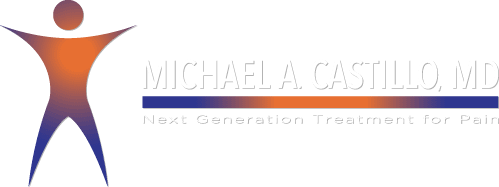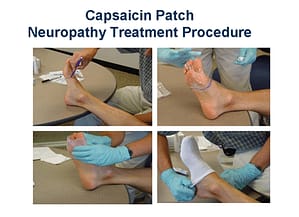Currently in the United States, capsaicin patches are approved for the treatment of postherpetic neuralgia, however they are not approved for diabetic neuropathic pain. In previous studies, capsaicin patches have demonstrated non-inferior efficacy to pregabalin in peripheral neuropathic pain, with faster onset of action, fewer systemic side effects, and greater treatment satisfaction. Therefore, researchers set out to evaluate the efficacy and safety of capsaicin patch compared to placebo in patients with painful diabetic peripheral neuropathy.
Researchers conducted a phase III, multi-center, double-blinded, placebo-controlled, 12-week study, which included 369 patients with painful, distal, symmetrical, sensorimotor diabetic polyneuropathy, which lasted at least a year in duration. Patients either received capsaicin patch or placebo patch to painful areas of the feet for 30 minutes. The patients had a mean pain duration of 5.8 years, HBA1c of 7.3%, and an average daily pain score of 6.5 (Brief Pain Inventory-Diabetic Neuropathy [BPI-DN]). The primary endpoint was percentage change in average daily pain score from baseline to between weeks 2-8. Secondary endpoints included weekly average daily pain, 30% responder rates, BPI-DN sleep interference score, and weekly sleep interference score.
Capsaicin patch is used for:
Treating a certain type of nerve pain caused by the shingles (postherpetic neuralgia). It may also be used for other conditions as determined by your doctor.
Capsaicin patch is a TRVP1 channel agonist. It works by decreasing certain pain receptors on some nerve endings.
Do NOT use capsaicin patch if:
you are allergic to any ingredient in capsaicin patch
Contact your doctor or health care provider right away if any of these apply to you.
Before using capsaicin patch:
Some medical conditions may interact with capsaicin patch. Tell your doctor or pharmacist if you have any medical conditions, especially if any of the following apply to you:
- if you are pregnant, planning to become pregnant, or are breast-feeding
- if you are taking any prescription or nonprescription medicine, herbal preparation, or dietary supplement
- if you have allergies to medicines, foods, or other substances
- if you have broken or damaged skin at the application site
- if you have a history of high blood pressure, other heart problems, or recent heart attack or stroke
Some MEDICINES MAY INTERACT with capsaicin patch. However, no specific interactions with capsaicin patch are known at this time.
Ask your health care provider if capsaicin patch may interact with other medicines that you take. Check with your health care provider before you start, stop, or change the dose of any medicine.
How to use capsaicin patch:
Use capsaicin patch as directed by your doctor. Check the label on the medicine for exact dosing instructions.
Capsaicin patch is usually applied at your doctor’s office, hospital, or clinic. If you will be using capsaicin patch at home, a health care provider will teach you how to use it. Be sure you understand how to use capsaicin patch. Follow the procedures you are taught when you use it. Contact your health care provider if you have any questions.
Do not remove the patch from the sealed pouch until right before use.
You may receive other medicine to treat pain that occurs during and after your treatment with capsaicin patch. Discuss any questions or concerns with your doctor.
Do not touch the patch while it is on your skin. Burning or stinging may occur.
If you miss a dose of capsaicin patch, contact your doctor right away.
Ask your health care provider any questions you may have about how to use capsaicin patch.
Important safety information:
Do not use capsaicin patch on the face or scalp. Do not get it in the eyes, nose, mouth, or genital area. If you get capsaicin patch in any of these areas, rinse right away with cool water.
Do not inhale any of capsaicin patch. It may cause shortness of breath, coughing, or sneezing. Tell your health care provider if any of these symptoms occur.
Do not get capsaicin patch on skin that is not being treated. Tell your health care provider if capsaicin patch comes into contact with skin that is not being treated.
The treated area may be sensitive to heat (eg, hot showers or baths, direct sunlight, strong exercise) for a few days after capsaicin patch is applied.
Lab tests, including blood pressure, may be performed while you use capsaicin patch. These tests may be used to monitor your condition or check for side effects. Be sure to keep all doctor and lab appointments.
Capsaicin patch should be used with extreme caution in CHILDREN younger than 18 years old; safety and effectiveness in these children have not been confirmed.
PREGNANCY and BREAST-FEEDING: If you become pregnant, contact your doctor. You will need to discuss the benefits and risks of using capsaicin patch while you are pregnant. It is not known if this medicine is found in breast milk. Do not breast-feed on the day of treatment after you have received your treatment with capsaicin patch.
Possible side effects of capsaicin patch:
All medicines may cause side effects, but many people have no, or minor, side effects. Check with your doctor if any of these most COMMON side effects persist or become bothersome:
Mild pain, redness, burning, or itching at the application site; mild sore throat; nausea.
Seek medical attention right away if any of these SEVERE side effects occur:
Severe allergic reactions (rash; hives; itching; difficulty breathing; tightness in the chest; swelling of the mouth, face, lips, or tongue); blisters or swelling at the application site; severe or persistent dizziness or headache; severe or persistent pain, redness, burning, or itching at the application site; shortness of breath, coughing, or sneezing.
This is not a complete list of all side effects that may occur. If you have questions about side effects, contact your health care provider. Call your doctor for medical advice about side effects. To report side effects to the appropriate agency, please read the Guide to Reporting Problems to FDA.
 Skip to content
Skip to content

